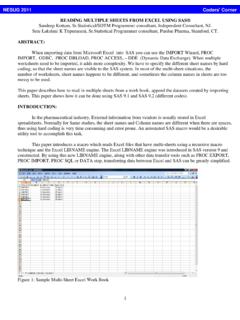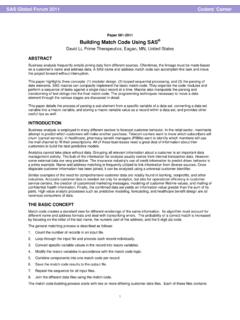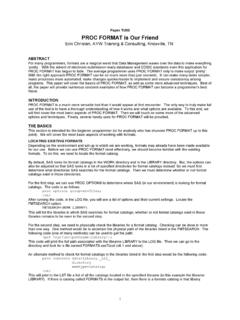Transcription of SUGI 26: How Many Observations(r) Are In My Data Set?
1 Paper 95-26 how many observations Are In My Data Set?Jack Hamilton, First Health, West Sacramento, CaliforniaABSTRACTThis paper presents a macro which returns the number ofobservations in a SAS data set or view, with an optional WHERE clause, and an additional macro which indicates only whether thedata set or view is sometimes happens that a SAS program needs to know howmany observations are in a SAS data set. The traditional, andfastest, method is to use the NOBS= option on a SET statement,but this method does not always return the correct number. Thispaper describes some of the problems with the NOBS= solution,and presents a macro as an alternative WORKS WITH AN ORDINARY DATA SETS uppose you have an ordinary data set, one that you ve justcreated:data row1col1;a = 12;output;run;If you use the NOBS= option on a SET statement, you can findthe number of observations in the data set:data _null_;put nobs=;stop;set row1col1 nobs=nobs;run;printsNOBS=1 THE PROBLEMThe problem is that the NOBS= option doesn t produce correctresults for all types of data DOESN T WORK WITH AN EDITED DATA SETA data set which has been edited in place may not return thecorrect number:data delobs.
2 A = 12;output;run;data delobs;modify delobs;remove;run;data _null_;put nobs=;stop;set delobs nobs=nobs;run;will print NOBS=0 on OpenVMS (SAS ), which is correct, butNOBS=1 on Windows (SAS ) and Unix (SAS ), which DOESN T WORK WITH A DATA STEP VIEWThe NOBS= option also doesn t work with a data step view:data datav1 / view=datav1;set row1col1;run;data _null_;put nobs=;stop;set datav1 nobs=nobs;run;printsNOBS=2147483647 Plausible, if you happen to have a really large dataset, DOESN T WORK IN VARIOUS OTHER CASESNOBS= also doesn t work with transport data sets, SQL views(including database passthrough views), and in some WHAT?Use of the NOBS= option is OK if you just created the data setearlier in the same program, or if you have some other way ofknowing for certain how the data set was created and the other hand, if you don t know how the data set wascreated or how it might have been manipulated, it s not safe touse NOBS=.
3 In particular, if you re writing a general purposeprogram or macro that might be used by anyone on an arbitrarydata set, you should not use NOBS= to count problem was not obvious in the past, when views andtransport data sets weren t common. But these days, a data setmight come from anywhere you might be dealing with a real data set, or a view, or an external database, or a real data set ona different SOLUTIONOne solution to this problem (the solution I present here) is tocreate a general-purpose macro which returns the number ofobservations in a data set, regardless of how it was created. Themacros uses the data set information functions, new in latereleases of SAS version 6, to provide the information steps are:1.
4 Find out whether SAS knows how many observations thereare,2. If it does know, there s a function which returns the correctcount. Use it and you re If SAS doesn t know how many observations there are,iterate through the data set and advantage of this approach is that it supports where clauses,which NOBS= does not. Another advantage is that it isimplemented entirely in the macro language, and will not create astep boundary in the calling program. The primary disadvantageis that it can be slow for large of the code are shown below, and the complete macrois given at the end of the paper. A special case macro,MTANYOBS, is also shown; it checks whether there are anyobservations in the dataset, without counting SURE THE DATA SET EXISTSUse the OPEN function to make sure the data set exists; if itdoesn t, or can t be opened, return a missing value:%let DSID = %sysfunc(open(&DATA.))
5 , IS));%if &DSID = 0 %then%do;%put %sysfunc(sysmsg());%let counted = .;%goto mexit;%end;The OPEN function returns an internal pointer to the data set ifthe open succeeded, or 0 if the open the case of failure, use the SYSMSG function to getexplanatory text, set the return value to missing, and go to the open succeeded, the dataset pointer is stored in SAS KNOW THE ANSWER WITHOUT COUNTING?If SAS knows how many observations are in the data set, and ifthere s no WHERE clause, you can get the answer directly:%let anobs = %sysfunc(attrn(&DSID, ANOBS));%let whstmt = %sysfunc(attrn(&DSID, WHSTMT));%if &anobs=1&&whstmt = 0 %then%do;%let counted =%sysfunc(attrn(&DSID, NLOBS));%end;The ATTRN function returns the value of a numeric attribute of adata set.
6 The ANOBS attribute is 1 if SAS knows the number ofobservations in the data set specified by DSID, and 0 if itdoesn t. The WHSTMT attribute is 0 if no where clauses areactive, and non-zero if there are active where SAS HAVE TO ITERATE?If SAS doesn't know the number of observations, or if you reusing a WHERE clause, you can obtain the answer by iteratingthrough the data set. This can be expensive, but it is your onlyreliable code is simple; just loop and increment a counter:%let counted = 0;%do %while (%sysfunc(fetch(&DSID)) = 0);%let counted = %eval(&counted. + 1);%end;The Fetch function obtains the next observation in the OF USAGEThe MTCNTOBS macro returns a number (as a string), and canbe used anywhere a number might WITHOUT A WHERE CLAUSEput "There are %MTCNTOBS(data=testdata) rowsin your table.
7 ";USAGE WITH A WHERE CLAUSE data _null_;%let obscount = %MTCNTOBS(data=skiing(where=(xc='Y' and open ='Y')));select (&obscount);when (0)put 'No XC resorts are open.';when (1)put '1 XC resort is open.';otherwiseput "&OBSCOUNT. XC resorts are open.";end;run;PRINTING A "NO OBSERVATIONS" PAGEIt's often desired to print out a special page if there are noobservations in a data set (if there are no records, PROC PRINTand other reporting procedures will print nothing). TheMTANYOBS macro can be used to do this:title 'Listing of Errors';proc print data=errors;run;data _null_;if %MTANYOBS(data=errors) = 0 thendo;file print;put "No errors were found.
8 ";end;stop;run;If there were errors, the PROC PRINT will execute but the PUTstatement in the data null will not. If there were no errors, thePUT will execute but the PROC PRINT will things to note here:1. The same title statements will be used in either This special case can be made simpler; you don't need toiterate through observations 2 through 10,000,000 afteryou've found the first observation . A revised macro,MTANYOBS, is found at the end of this & AWHY DOES ITERATION TAKE SO LONG?It appears to be a problem with the macro language rather thanthe FETCH function. The increment statement, which requiresconverting a string to a number, adding, and converting back to astring, is slow.
9 Running the FETCH function plus a counteragainst a million record dataset takes 671 seconds on a testmachine (Windows NT). A simple loop counting from 1 to1,000,000 takes 452 seconds on the same machine. In otherwords, two-thirds of the time is spent on simple integer 'S AN ALTERNATIVE?One alternative is to do the counting in a data step. This is morework to program, but is faster to execute. A data step which usesthe same counting technique as the MTCNTOBS macro takes 16seconds, as opposed to 671 seconds in the macro. If you'redealing with large datasets, it might be worth your time to avoidusing macros, even at the cost of creating additional 's the code used in a data step:16 data _null_;17 dsid = open('testdata(where=(class=3))', 'is');18 do while (fetch(dsid, 'noset') = 0);19 i+1;20 end;21 put i=;22 rc = close(dsid);23 stop;24 **; run;i=249974 NOTE: DATA statement used:real time secondsIt would not be difficult to "macrotize" this code so that it could beeasily included in the middle of a data step; the primary difficultywould be ensuring that there is no variable name collision.
10 Itwould also be easy to write a macro which creates a stand-alonedata step which saves its results into a macro variable. Thesemacros are left as an exercise for the reader (there's not room forthem in this paper).WHY NOT USE THE SET STATEMENT IN A DATA STEP?Another iterative solution in the data step might be:data _null_;do while (not nomore);set testdata (where=(class=3))end=nomore;i+1;end;put i=;stop;**; run;Unfortunately, this printsi=1000000 The END= option doesn't seem to take the WHERE clause are two other problems with the SET solution:1. It causes data movement, so you might see a speeddecrease for a data set with many variables, or largecharacter It brings variables into the data step, and those variablesmight interfere with something else you're I USE SQL?














